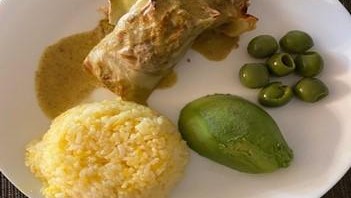Stuffed Cabbage Roll: It’s a Wrap
By Esther Boateng
It’s easy to get stuck in a food rut. We’ve all been there at some point in our lives. I remember a time when I existed solely on loaded potatoes, cheddar cheese and coleslaw. This was my go-to dish almost every day for about a year. I loved it. I could probably still eat it today. But there comes a time when we move on from childhood comfort foods and discover other culinary delights. I have a ‘gut’ feeling stuffed cabbage rolls could become one of my favorite go-to meals, and maybe yours too.
Cabbage roll, cabbage wrap, whatever you chose to call it, is an easy meal you can whip up in next to no time. The Swedish name for this recipe is Kåldolme. Swedes embraced this dish many years ago to the extent that it became part of their culture, even though it originally comes from Turkey. ‘Kal’ means cabbage in Swedish, and ‘dolme’ comes from the Turkish word ‘dolma,’ which means stuffed. This dish turns out well if you use regular cabbage leaves, but I prefer to use savoy cabbage. The leaves are easier to peel, and aesthetically, it looks more pleasing. Vine leaves - if you can find them - are also an option. In Sweden they like to use kale. I find kale leaves are too fibrous, even after baking, so I stick with savoy cabbage.

Kåldolme is a great way to use a package of ground beef or lamb that sometimes gets forgotten at the back of the fridge. I’ve lost count of the number of times I’ve thrown away ground meat due to an expired sell-by date.
The main ingredients in this recipe are ground beef, cabbage, and rice. As mentioned in a previous blog post, I prefer to buy grass-fed and grass-finished beef whenever possible, instead of industrially raised beef. Grass-finished beef contains roughly 2-4 times more omega-3 fatty acids than grass-fed beef. Omega-3 is an essential fat our bodies need for things like cognitive function, cardiovascular health, and hormonal health, among other functions. Also, grass-finished beef is more nutritious than grass-fed beef and tends to have higher levels of vitamin E and B vitamins, as well as potassium and magnesium.
As a student, Bolognese was on the menu every week, without fail. I never felt confident using fancy cuts of red meat, probably due to inexperience, so I relied on Bolognese made with ground beef as one of my go-to meals. As you can imagine, there’s only so many Bolognese meals you can eat before you get fed up with it. The same can is true with rice.
The love-hate relationship I have with rice probably dates back to my childhood. Chicken stew with rice was a staple dish in our household. During my student days, when I started to experiment with my own recipes, rice was strictly off the menu. For years, I steered clear of rice and chicken, but as the saying goes, absence makes the heart grow fonder.
Rice has made a comeback into my kitchen, and I welcome it with open arms. I don’t eat it every day, but when I do, I like to cook saffron infused rice, or maybe add turmeric, coupled with a dollop or two of ghee. As you might have guessed by now, I take every opportunity to add herbs and spices to most recipes; it’s an easy way to boost the nutrition of your meal, and it upgrades the taste enormously. It’s hard for me to enjoy rice unless it’s smothered in ghee with plenty of seasoning. Also, I prefer to eat white rice instead of brown rice; it has less phytates.
There is only a handful of Swedish foods and recipes I absolutely love, such as Borscht. Some of them are too exotic for my taste buds, like pickled herring, which is quintessentially Swedish. However, Kåldolme is a relatively simple and tasty recipe you can customize to suit almost any palate. If you like to experiment with food, and you’re feeling game, why not swop your standard ground beef for an ancestral blend that includes beef heart and beef liver? As always, your body will thank you for it.















Leave a comment